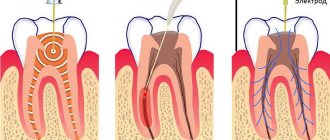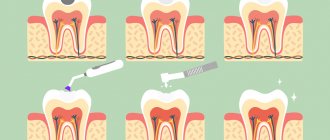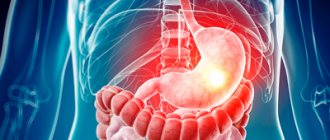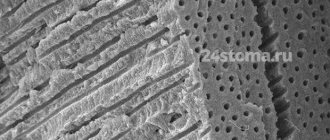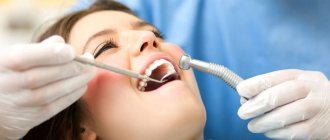Disease of the molars, diagnosed by specialists as pulpitis, is quite painful. Patients ask dentists during the initial examination whether it is painful to treat pulpitis. The painfulness of the inflammatory process is one of the reasons that patients are afraid of the treatment process. Treatment methods used by modern dentists minimize pain during the treatment process.
A fairly common question is: is it painful to treat pulpitis on distant teeth. Treatment of distant teeth, from the point of view of the techniques and equipment used by specialists, is not much different from the treatment of teeth in the smile zone. In addition, inflammation is characterized by the spread of painful sensations throughout the entire jaw, so it is sometimes difficult for the patient to understand which specific tooth is bothering him. Only a qualified dentist can identify the problem tooth during an examination.
Pulpitis of the tooth and its treatment
A characteristic sign of this pathology is inflammation in the pulp, which is located inside the tooth cavity, where blood vessels and nerves are concentrated. The cause of inflammation is the penetration of harmful bacteria into the cavity due to damage to the external dental tissues (enamel and dentin). This is the destruction that we most often owe to untimely treatment of deep dental caries: pulpitis becomes a consequence of the carious process. Much less often, it appears due to mechanical damage to the pulp, poor preparation of the tooth for filling, and unprofessional installation of orthopedic structures.
Treatment methods for pulpitis
In dentistry, two main methods are used to treat dental pulpitis in adults and children:
- biological - drug treatment of pulpitis with antibiotics and medications;
- surgical - treatment of pulpitis by amputation (partial removal of the pulp) or extirpation (in which the nerve of the tooth is completely removed).
The choice of technique remains with the dentist. The doctor studies X-ray diagnostic data, interviews and examines the patient. Based on these data, he selects the most rational method of treating pulpitis for a particular case.
Causes of pulpitis
Pulpitis develops due to infection. Untreated dental caries is the main cause of this disease. The carious cavity contains bacteria and microorganisms that gradually destroy the tooth. And when the destruction reaches the nerve, pain occurs.
Stages of pulpitis
The disease is characterized by different stages and its manifestations and intensity of pain.
Purulent pulpitis
This acute stage manifests itself as unbearable, constantly throbbing pain. It intensifies in the evening, sometimes patients wake up at night from a painful attack. Pain occurs not only in the area of the affected tooth, but also radiates to the jaw, ear, and temple. Cold water can help relieve pain, but it is important to remember that easing the symptoms of the disease is not a cure. It is necessary to eliminate the cause – inflammation. If this is not done, necrotic decay of the nerve will begin.
Acute pulpitis
Acute toothache that occurs when eating hot/cold food or when a stream of air hits the tooth is the main symptom of such pulpitis. The pain goes away after the irritant is removed. Sometimes the pain subsides for a long time.
But since the pain appears, it means that there is serious inflammation in the tooth, which arose due to caries. Microorganisms entered the nerve and pain appeared. At this point, the disease is characterized by severe pain with throbbing. It occurs in the evening and at night, maybe only a couple of minutes or even persists throughout the day.
Chronic pulpitis (gangrenous)
This form appears when pulpitis is already advanced, and no treatment has been carried out for a long time. Under the influence of external stimuli, pain appears, as soon as the stimuli are eliminated, it goes away.
The most dangerous thing about gangrenous pulpitis is that the pain can occur suddenly. It is characterized as a strong pulsation. Sometimes there is a “dull” soreness. Often, at the time of treatment of this form, there is some pain and bleeding from the tooth.
Sometimes the disease can occur without symptoms. For example, when there is no obvious carious cavity, therefore, irritants do not enter the tooth and do not cause pain.
Types of pulpitis
The dentist’s treatment tactics will depend on which tooth this disease occurs on.
Front tooth
The symptoms will be the same as on chewing teeth. It is not difficult to diagnose such pulpitis. In addition to the main clinical picture, the tooth pulp will be visible through the enamel. Pain of unclear localization often occurs: the patient points to a completely different tooth. In addition to the main treatment, painkillers are prescribed, and when filling the crown of the tooth, the aesthetics are carefully restored.
Pulpitis of wisdom tooth
On this tooth, pulpitis develops for the same reasons as on other teeth and the clinical manifestations are the same. Often it is not possible to treat “figure eights”, since they are located very far away, have a complex anatomy, or even grow “into the cheek”. Therefore, in such a situation, tooth extraction is prescribed.
What happens if pulpitis is not cured?
Any disease cannot go away on its own unless the cause is eliminated. Pulpitis of the tooth is no exception. The infection in the tooth will only spread, the nerve will die, and microorganisms will spread beyond the root of the tooth into the bone tissue - into the periodontium. If pulpitis is not cured, periodontitis will occur.
Complications can also include deterioration of the condition of the tooth, through the transition of one stage of the disease to another: a purulent form to a gangrenous form or to nerve necrosis. If you do not pay attention to the first symptoms and neglect the tooth, the treatment will be much more expensive, and sometimes even tooth extraction will be required.
Patients often turn to the doctor late, since pulpitis is asymptomatic. This is the danger of this disease: there is no concern, but the inflammatory process continues and affects more and more tissues. Or a slight pain occurs, then quickly passes, and the patient thinks that everything is fine with the tooth. It is important not to forget that if tooth pain ever occurs, there is a reason to consult a dentist.
Methods and methods for treating pulpitis (how is tooth pulpitis treated?)
Many patients have the opinion that treatment of pulpitis is very painful, but in fact, modern dentistry has done everything to make the treatment comfortable. In any case, the treatment method and the number of visits are determined only by the dentist after examination. Based on objective data, x-rays and medical history, a decision is made on the choice of treatment tactics.
Treatment of pulpitis in one visit
Such treatment is possible if the tooth has a minor carious cavity, there is no extensive damage, and the infection has spread slightly. Based on these data, and also if the patient agrees to carry out treatment immediately, the doctor begins his manipulations.
Treatment in two visits
If the pulpitis has a complex shape, or the tooth is severely damaged by caries, then two or more visits are prescribed. Then all non-viable tooth tissue is removed, the nerve is removed, the canal is washed and treated. The doctor will tell you more about these manipulations during the consultation and will allocate time for subsequent visits. Each visit, the doctor observes the tooth and, if necessary, can change the number of visits and the scheme of treatment procedures.
Surgical method for treating pulpitis
It involves removing the nerve from the tooth, and, if conditions exist, the doctor preserves the root pulp. If the nerve is completely removed, then the canals are cleaned and sealed. If the nerve is partially removed, a filling is placed on the tooth and its anatomical shape is restored.
Laser treatment of pulpitis
This method appeared in dentistry relatively recently. It is characterized by its painlessness. It is necessary to cauterize the nerve with a special laser without removing it. This technique allows you to save the nerve. First, a temporary filling is placed on the tooth, the doctor observes the tooth for a certain time, if there have been no relapses, the treatment is completed - a permanent filling.
Biological method of treating pulpitis (treatment of pulpitis without removing the nerve)
This method is conservative and involves preserving the pulp. It is recommended when the inflammation is not severe, or, for example, with a reversible form of pulpitis. Special medications are used.
How long does treatment take?
All cases are strictly individual and depend on the initial clinical picture. But there are two schemes: treatment in one visit and in two. In the latter case, the tooth is first covered with a temporary filling, and after a certain time the doctor completes the treatment.
What to do after treating pulpitis?
The doctor will tell you everything that needs to be done after treatment. Recommendations include avoiding too cold/hot food and eating after a while. In difficult clinical situations, a lack of physical activity and rest may be required.
Treatment of pulpitis during pregnancy
Pregnancy is a physiological state that requires increased attention to the health of mother and child. But when pain occurs, it is contraindicated to endure it or self-medicate. This can lead to serious complications affecting not only the oral cavity, but also the pregnant woman’s body as a whole.
Under no circumstances should treatment be delayed, as this can lead to serious consequences. During the consultation, the dentist will help you choose a safe treatment method that will not harm mother and baby. The method of pain relief is also carefully selected. In addition, X-ray examinations are not prescribed (except for complex clinical cases).
At the initial consultation, you must tell the doctor about the duration of your pregnancy and, if any, any health conditions (for example, the presence of allergic reactions or heart and vascular diseases). After the examination, the dentist will make a diagnosis and tell you when to start treatment.
The dentist will provide you with the most complete information about the condition of your teeth and the need for their treatment. Frequently asked questions during the consultation: is it painful to remove a nerve, is it possible to do without removing it, when does a tooth need to be removed, does the treatment take place in one visit, what is the cost of treatment, etc. Our specialists will tell you in detail about everything related to dental treatment.
Biological method of treating pulpitis
If the disease has become chronic, a biological method or conservative treatment of pulpitis with calcium is used. The process involves applying therapeutic pads containing calcium preparations. The technique is also used in the following cases:
- if the pulp was accidentally exposed during the caries treatment procedure;
- when you need to strengthen the bone partition between tooth enamel and pulp.
The specialist applies a drug for the treatment of pulpitis to the site of thinning bone tissue and thereby strengthens it. Next, the tooth is filled and monitored over time, conducting X-ray examinations at certain time intervals. The method is suitable:
- children with baby teeth;
- patients under 30 years of age during the treatment of reversible pulpitis;
- everyone who takes special care of their oral cavity.
If, after treatment of pulpitis, the tooth aches, hurts when pressed or bitten, and the pain remains for a long time, intensifies at night, and becomes long-lasting, you must return to the clinic. Aching pain during the treatment of pulpitis indicates that more radical, that is, surgical, methods are needed.
Exacerbation
Chronic pulpitis often occurs asymptomatically or with minor painful manifestations, but sooner or later the patient will experience an exacerbation of the pathology. In addition to the fact that it is unbearably painful, it is also dangerous due to various complications (abscess, sepsis).
Two types of chronic pulpitis are prone to exacerbation - gangrenous and fibrous. Symptoms manifest themselves in the form of sudden pain that regularly occurs both during the day and at night. Often the pain radiates to the ears, back of the head or temporal part.
Causes:
- hypothermia;
- infectious diseases of the intestines, respiratory tract and other organs;
- decreased immunity;
- frequent contact of the affected tooth with cold, hot or excessively hard food.
While the patient self-medicates and postpones visiting a doctor, the destructive process progresses rapidly. After suppuration on the roots and tissue death begins, it is no longer a question of eliminating pulpitis, but of saving the infected tooth.
How is pulpitis treated surgically?
As we have already noted, there are two possible options for surgical intervention:
- treatment of pulpitis using the amputation method with partial preservation of the pulp;
- treatment with complete removal of soft tissues, blood vessels, and nerves.
If there is an objective possibility, the doctor will remove only the top of the pulp - from the crown, leaving the root part. The blood supply and sensitivity (innervation) of the tooth will be preserved. The technique is used in the treatment of children - for milk or permanent teeth that have not yet fully grown. This allows them to form normally in the future. Treatment for pulpitis can be carried out in one visit.
What disease will develop in a patient with deep caries: acute or chronic pulpitis?
In practice, everything depends on the characteristics of the pathogenic bacteria - the causes of the disease, as well as on the characteristics of the dental tissues. Statistics in dentistry show that the older the patient, the more often he develops chronic, permanent pulpitis instead of acute pulpitis. An older patient, as a rule, cannot identify a diseased tooth himself, since he does not feel the acute symptoms of pulpitis. “My whole jaw hurts,” a patient with chronic pulpitis usually tells the dentist. This is explained by the spread of toothache along the trigeminal nerve of the jaw, as a result of which it is very difficult to identify the causative tooth based on pain alone. There are often cases when the patient thinks that the cause of the pain is the opposite tooth on the other side of the jaw. To make a more accurate diagnosis before the examination, it is recommended to perform teeth whitening with ultrasound, which will allow a more realistic assessment of carious damage to the teeth and their general condition.
Among the varieties of acute pulpitis, it is worth highlighting acute purulent diffuse pulpitis and acute serous-purulent focal pulpitis. Cold water helps determine which type of disease a particular patient has. When a diseased tooth comes into contact with it, the pain subsides with purulent pulpitis, and worsens with serous-purulent pulpitis.
To get rid of toothache before visiting the dentist, many of us are accustomed to turning to analgesics and other painkillers. But, unfortunately, they do not always help. A carbolic acid based mixture may be a good alternative. To prepare it you need 1-2 drops of 3% acid, trimecaine or novocaine powder. A small portion of the mixture (the size of a match head) is applied to the bottom of the carious cavity and covered on top with a cotton swab soaked in collodium. This bandage will not only help relieve pain, but will also cauterize the inflamed pulp. With the help of such a remedy, you can relieve the annoying toothache for 1-2 days in order to wait until professional dental care is provided. However, eliminating toothache for several days is not a reason to use this remedy constantly and refuse dental care. To avoid complications of pulpitis, the tooth must be treated before the onset of another attack of pain. Otherwise, chronic pulpitis will develop.
Olga Aleksandrovna Bunkova I would like to express my gratitude to Tatyana Vitalievna Varlamova. A very sensitive and talented doctor, I had a difficult tooth, in another clinic they offered to remove it, and Tatyana Vitalievna fought for it with tenacity and the result exceeded expectations! I treated my teeth only with her for further treatment and recommend her to all my acquaintances and friends! Olga Aleksandrovna Bunkova I would like to express my gratitude to Tatyana Vitalievna Varlamova. A very sensitive and talented doctor, I had a difficult tooth, in another clinic they offered to remove it, and Tatyana Vitalievna fought for it with tenacity and the result exceeded expectations! I treated my teeth only with her for further treatment and recommend her to all my acquaintances and friends! B B B B B B B B
December 7, 2010 — Tuesdaycomments: —>
Pulpitis is an inflammation of the dental pulp , or, as it is often called, the dental nerve. Dental pulp is a soft tissue located in the internal cavity of the tooth. The dental pulp consists mainly of nerve fibers and blood vessels. In a healthy tooth, the pulp practically does not reveal its presence, but as soon as it becomes inflamed, the person is ready to “climb the wall” from unbearable toothache. It is for this reason that treatment of pulpitis is primarily aimed at eliminating pain symptoms.
Treatment of acute pulpitis
The above methods are ineffective in treating exacerbations of chronic pulpitis, an acute disease when the tooth becomes a source of unbearable pain radiating to the ear, temple, and back of the head. With these symptoms, endodontic treatment of pulpitis is carried out - with cleaning of the root canals and complete removal of the pulp.
In dentistry, two modern methods of treating tooth canals for pulpitis are used: devital and vital.
- Treatment of pulpitis using the vital amputation method is carried out by removing the nerve, washing, cleaning and filling the canal.
- Devital treatment of pulpitis involves the use of medicinal pastes and requires several sessions.
These treatment methods are most often used for pulpitis on permanent teeth.
Allergy
This complication of pulpitis treatment is easier to differentiate - an allergic reaction is often accompanied by tissue swelling. If it is a consequence of material moving outside the root canal, there may be swelling of the gums around the treated tooth. In some cases, it spreads to other areas - cheek, lip, depending on the specific tooth.
When pressure is applied, the pain becomes stronger, it is difficult to relieve with painkillers, and over time it only intensifies.
Stages and stages of tooth treatment for pulpitis using the devital method
- Stage I.
The tooth is anesthetized and the carious cavity is cleaned. The pulp cavity is opened. - Stage II.
A devitalizing paste is placed into the exposed pulp and the tooth is filled for 3 to 7 days. People still call the paste “arsenic,” although it has nothing to do with this substance. - Stage III.
During your next visit, your dentist will clean the root canals according to medical protocol. - Stage IV.
If there is a risk that the tooth will crack, it is covered with a crown. If the hard tissues are well preserved or only slightly damaged, they are restored. The tooth is strengthened with a fiberglass or metal anchor pin and securely filled with photopolymer material.
The treatment time for pulpitis depends on how damaged the tooth is, the age of the patient, whether there are complications, and how many root canals should be treated.
Diagnostics
At the first appointment, the dentist conducts a thorough examination, and during the conversation he finds out the nature of the pain syndrome, how long ago it appeared, under what circumstances.
The purpose of instrumental diagnostics is to identify a carious cavity, assess the degree of softness of the pulp, as well as the general condition of the soft tissues.
After this, the patient is sent for an X-ray examination, which can be used to determine the severity of the pathological process, its location and the size of the lesion. X-ray is an informative technique, since after receiving the results, the doctor can determine the condition of not only external tissues, but also internal structures, including deep root canals.
Sometimes electroodontodiagnosis is performed to confirm the diagnosis. The procedure is based on analyzing the reaction of the affected tooth to electrical waves. During the examination, the doctor determines the integrity and functioning of the nervous system. In the absence of pathologies, the pulp responds to the current passing through it with minor discomfort. If a patient develops caries, the sensitivity of the nerve fibers decreases, so there may be no response.
Important!
Electroodontodiagnosis is not performed if the patient wears a pacemaker, has intolerance to electric current, or has been diagnosed with mental disorders of any severity.
Is it painful to treat pulpitis?
Many patients believe that treatment for pulpitis is painful. In fact, pain accompanies the disease itself, and not the procedure for its treatment. The pulp tissue and nerves become inflamed, which causes unbearable painful sensations comparable to an electric shock. Pulp removal is absolutely comfortable, because high-quality anesthetics completely relieve the patient of pain while the doctor prepares the canals. During treatment or after treatment of pulpitis, the tooth hurts when the internal tissues are severely inflamed. Then safe painkillers are prescribed while healing occurs (1 - 3 days).
Reasons for the development of the disease
- untreated caries or poor quality of filling, when an inflammatory process has developed again under the installed filling,
- preservation of the nerve under the crown - in this case (if the tightness of the prosthesis is broken, there is inflammation underneath) there is a high risk of pulp inflammation,
- tooth injury – inflammation penetrates from the outside, i.e. through cracks and chips that are located on the root or in close proximity to it,
- exposure to aggressive stimuli - temperature and chemical, for example, during previous canal treatment, naturally, with an incorrectly selected dosage of the drug.
Possible complications
If you delay visiting the dentist, inflammation can spread to the bone tissue of the tooth - periodontium. This is how one of the most common and dangerous complications of this disease begins - periodontitis, which can lead to tooth extraction. Periodontitis also occurs due to an unskilled approach to cleaning root canals.
If you are concerned about an elevated temperature after treatment for pulpitis, urgently contact a more reputable dentist, as the inflammation is progressing. Professional clinics use modern methods of canal treatment using microscopes, binoculars, visiographs, endomotors, and apex locators. These instruments prevent the risk of complications.
Unfortunately, pulpitis remains a common occurrence after caries treatment. The reason for its appearance is the same - the unprofessional actions of a doctor who violated medical protocols and made mistakes when filling. Perhaps he accidentally opened the pulp and gave bacteria access to it.
Why are patients afraid to remove nerves in a tooth?
Previously, in the process of removing a nerve in a tooth, dentists used arsenic by applying it to the affected pulp. The patient was then given a temporary filling, which was removed two days later along with the arsenic, after which the nerve was removed. This procedure took quite a long time, causing discomfort. Currently, thanks to modern technologies, the process of removing a nerve in a tooth lasts about half an hour and is carried out under local anesthesia. If the X-ray results are good, the canals and the carious cavity, cleared of bacteria, are filled.
To avoid such radical actions as removing a nerve in a tooth, you must:
- Carry out hygiene procedures as efficiently as possible
- Don't forget the importance of professional teeth cleaning
- Regularly visit the dentist, who will notice any carious lesion during a visual examination much earlier than it reaches the pulp and requires removal of the nerve.
How much does tooth treatment for pulpitis cost?
The final cost of pulpitis treatment is influenced by many factors: the degree of destruction of hard tissue, the number of canals in the tooth, the presence of complications, concomitant diseases, and the chosen treatment method. If the tooth is permanent and has one canal, then the procedure in Moscow clinics will cost from 5,000 rubles. This amount includes a full range of services: x-ray diagnostics, application of anesthetic, installation of a rubber dam, treatment of caries, treatment of dental canals with cleaning, installation of a filling. Price may change if multiple sessions are required.
